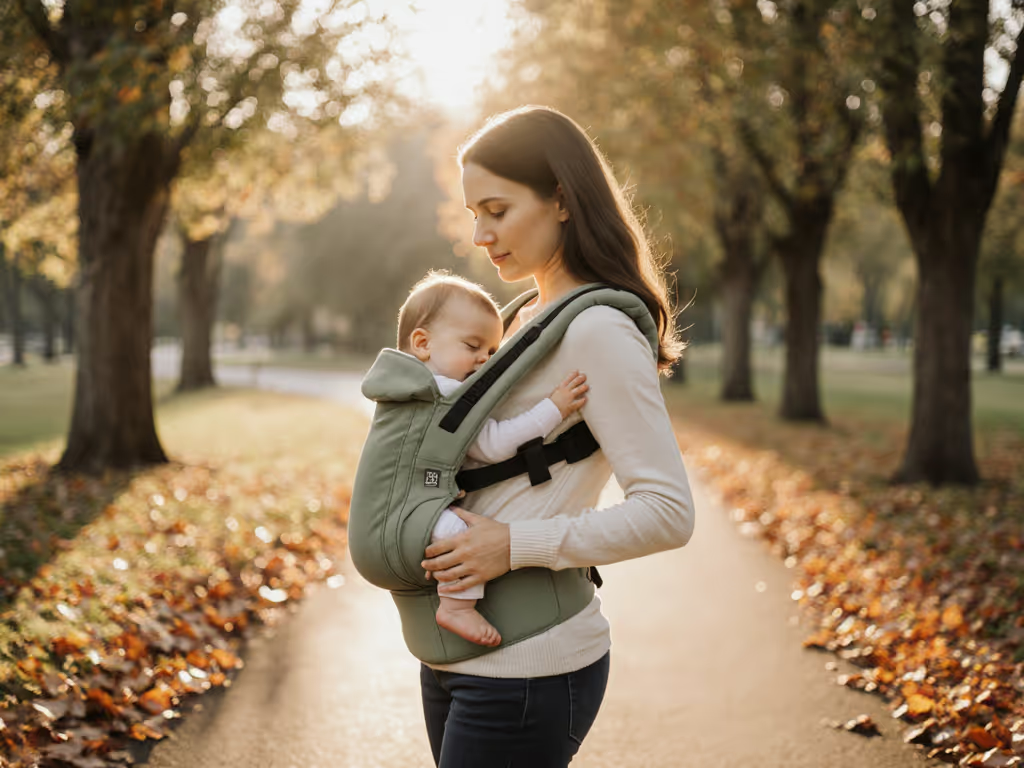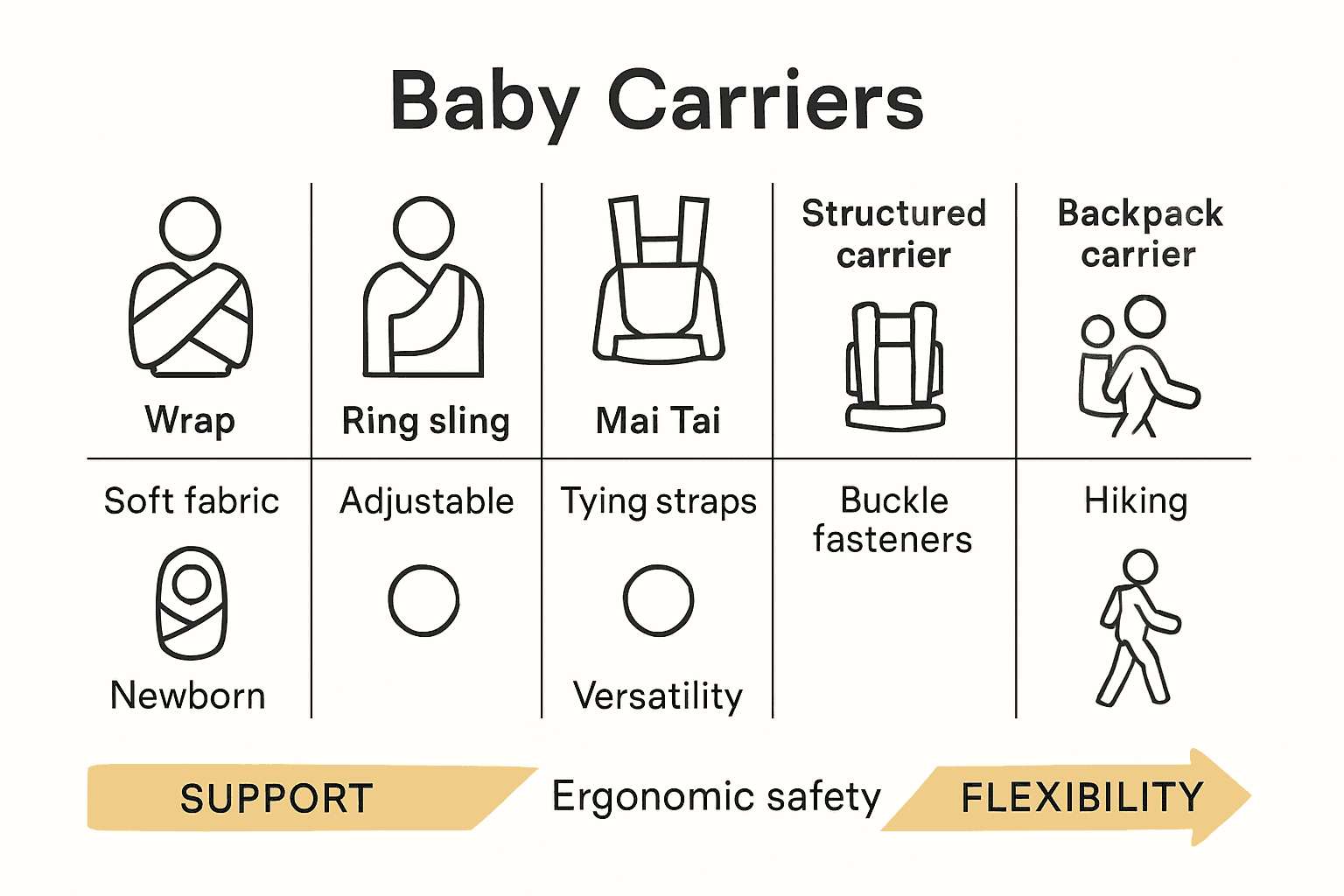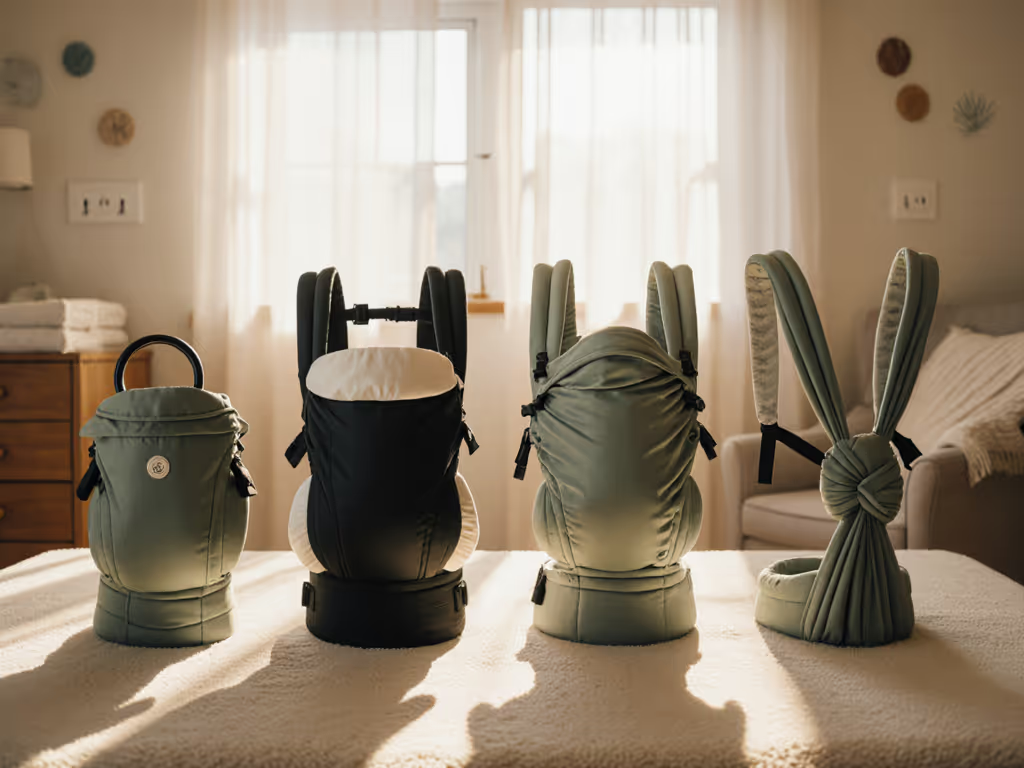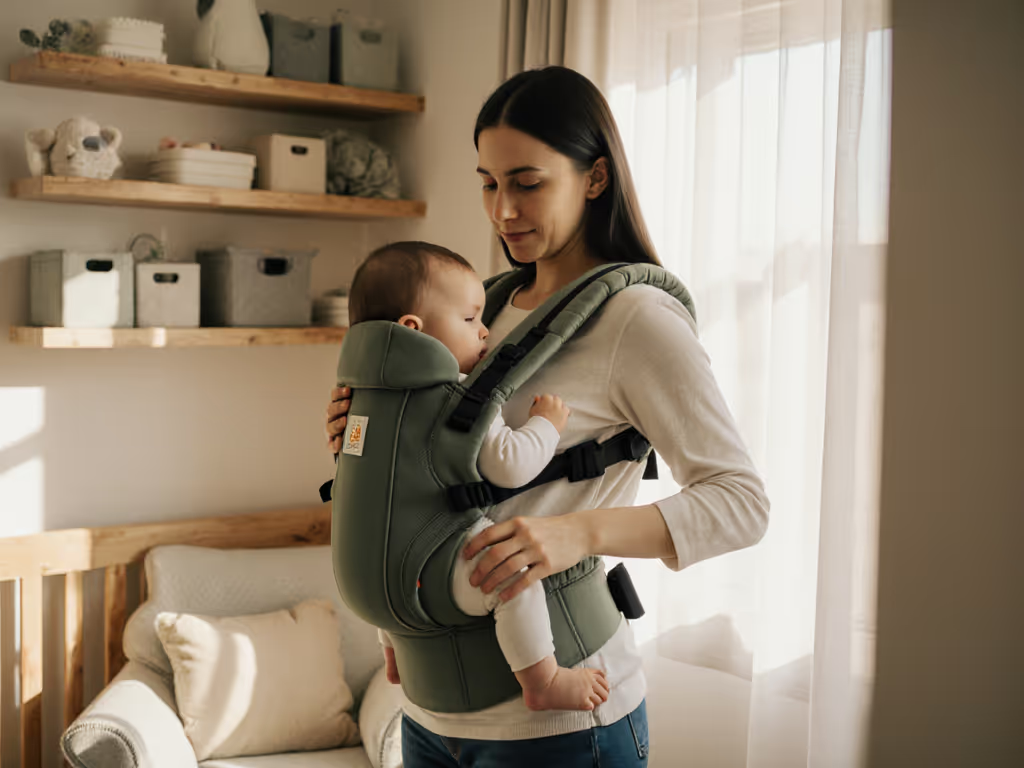
Babywearing Benefits Explained: Complete Guide for Parents

Did you know that infants who are frequently carried show up to 43 percent less crying than those who are not? Babywearing connects caregivers with time-tested techniques that encourage secure attachment and healthy development. As research uncovers the deeper biological, ergonomic, and emotional benefits, parents are discovering how this simple act strengthens both confidence and bond while making everyday life with a baby more connected and comfortable.
Key Takeaways
| Point | Details |
|---|---|
| Benefits of Babywearing | Supports emotional bonding, enhances neurological development, and provides practical caregiving advantages. |
| Types of Carriers | Understanding the characteristics of different carriers helps parents select the right one based on their needs and their child's age. |
| Safety Guidelines | Proper positioning and carrier integrity are crucial for infant safety, including maintaining the optimal 'M-position' and airway protection. |
| Debunking Myths | Knowledge of common myths about babywearing can empower parents to embrace this practice confidently, enhancing their child's independence and emotional security. |
Defining Babywearing and Core Concepts
Babywearing is more than just a parenting trend—it's a time-honored practice of keeping your infant close while maintaining hands-free mobility. At its core, babywearing involves using a specialized carrier or wrap to securely hold an infant against the caregiver's body, creating an intimate physical connection that supports both emotional bonding and practical caregiving needs.
The biological significance of babywearing extends far beyond convenience. A comprehensive 2023 scoping review published in the Journal of Obstetric, Gynecologic, and Neonatal Nursing highlighted several critical dimensions of this practice:
- Increased Physical Contact: Promotes secure attachment between infant and caregiver
- Physiological Synchronization: Supports mutual regulation of body temperature and heart rates
- Enhanced Communication: Facilitates more frequent infant-caregiver vocalizations
- Biomechanical Support: Ensures proper positioning that supports infant development
From an ergonomic perspective, systematic research suggests that structured baby carriers offer significant advantages over traditional arm-carrying methods. A recent scientific review found that well-designed carriers reduce physical strain by distributing an infant's weight more evenly, minimizing muscle activation and postural challenges for the caregiver. By understanding these core concepts, parents can approach babywearing as a scientifically supported method of nurturing that benefits both child and caregiver.
Types of Baby Carriers and Uses
Navigating the world of baby carriers can feel overwhelming, but understanding the unique characteristics of each type helps parents choose the right solution for their specific needs. Soft-structured carriers (SSCs) have emerged as a popular modern option, offering versatility that adapts from newborn stage through toddlerhood with multiple carrying positions including front, hip, and back configurations.
The primary carrier types include:
- Wraps: Long, flexible fabric that provides customizable wrapping techniques
- Ring Slings: Quick-adjust fabric with rings for secure, one-shoulder carrying
- Mei Tais: Traditional Asian-inspired carriers with wide straps and rectangular body panel
- Soft-Structured Carriers: Structured design with buckles, padding, and structured waistband
- Backpack Carriers: Robust design ideal for outdoor adventures and hiking
Each carrier type presents unique advantages and considerations. Wraps offer incredible skin-to-skin contact and adaptability for newborns, while soft-structured carriers provide more structure and support as babies grow. Parents should consider factors like infant's age, personal comfort, activity level, and physical demands when selecting a carrier.

Here's a comparison of the main types of baby carriers:
| Carrier Type | Key Features | Best For |
|---|---|---|
| Wraps | Custom fit<br>Flexible fabric<br>Skin-to-skin contact | Newborns<br>Bonding time |
| Ring Slings | Quick adjust<br>One-shoulder carry<br>Compact | Short trips<br>Breastfeeding |
| Mei Tais | Wide straps<br>Panel design<br>Tie closure | Versatility<br>Toddlers |
| Soft-Structured Carriers | Buckles & padding<br>Supportive<br>Multiple positions | Everyday use<br>Older babies |
| Backpack Carriers | Rigid frame<br>Storage pockets<br>Outdoor design | Hiking<br>Active parents |

Safety remains paramount when choosing and using any baby carrier. Modern carrier designs prioritize ergonomic positioning that supports healthy hip development and prevents suffocation risks. Regardless of carrier type, proper positioning—ensuring an open airway, supported spine, and spread-squat leg position—is crucial for infant safety and comfort.
Key Benefits for Babies and Caregivers
Babywearing is far more than a convenient parenting technique—it's a powerful approach to nurturing that delivers profound benefits for both infant and caregiver. Physiological synchronization emerges as a cornerstone benefit, where close physical contact enables remarkable biological connections that support developmental and emotional well-being.
For infants, the advantages are comprehensive:
- Neurological Development: Enhanced sensory stimulation and emotional security
- Emotional Regulation: Reduced stress through consistent physical proximity
- Motor Skill Enhancement: Natural exposure to caregiver's movement patterns
- Communication Skills: Increased opportunities for vocal and non-verbal interaction
Caregivers experience equally significant benefits. The 2023 scoping review revealed that babywearing promotes maternal empowerment and comfort, with ergonomic carriers specifically reducing physical strain. By distributing an infant's weight more effectively, these carriers minimize muscle activation and postural challenges, enabling longer, more comfortable periods of infant carrying.
Perhaps most critically, babywearing facilitates a profound bonding experience that transcends physical proximity. The constant sensory connection—hearing heartbeats, feeling movement, experiencing shared warmth—creates a neurological and emotional foundation for secure attachment. This intimate practice transforms caregiving from a task into a deeply interactive, mutually responsive relationship that supports healthy developmental trajectories for both infant and caregiver.
Safety Guidelines and Proper Positioning
Babywearing safety is paramount, requiring careful attention to positioning, carrier selection, and situational awareness. The fundamental principle is maintaining an infant's optimal physiological alignment—ensuring proper hip support, spine positioning, and airway protection through intentional carrying techniques.
Key safety considerations include:
- Infant Positioning: Maintain the "M-position" with spread-squat legs
- Airway Protection: Keep baby's face visible and chin off chest
- Carrier Integrity: Regularly inspect carrier for wear and structural damage
- Weight Limits: Strictly follow manufacturer recommendations
- Activity Restrictions: Avoid high-risk movements while carrying
The critical "M-position" involves positioning the baby with knees higher than their bottom, creating a spread-squat stance that naturally supports healthy hip development. This prevents potential hip dysplasia risks and ensures proper musculoskeletal alignment. Parents should be particularly cautious during activities like cooking, cleaning, or exercise, where unexpected movements could compromise infant safety.
Practical safety recommendations extend beyond positioning. Caregivers should practice carrier adjustments in a safe environment, verify secure fastening before movement, and remain consistently aware of the infant's positioning and comfort. Continuous monitoring is essential—checking breathing, temperature, and overall infant response throughout the babywearing experience ensures a safe, comfortable experience for both caregiver and child.
Common Myths and Misconceptions
Babywearing myths persist despite growing scientific evidence supporting this nurturing practice. Many parents hesitate due to widespread misconceptions that can prevent them from experiencing the profound benefits of close infant carrying. Understanding the truth behind these myths is crucial for confident, informed caregiving.
Widespread myths include:
- Myth: Babywearing spoils babies and makes them overly dependent
- Reality: Close contact actually promotes healthy independence and secure attachment
- Myth: Carriers are unsafe or bad for infant hip development
- Reality: Proper carriers support natural hip positioning and musculoskeletal growth
- Myth: Babies will overheat or experience disrupted sleep patterns
- Reality: Carrier proximity helps with natural thermoregulation and sleep rhythms
Parents often worry that constant carrying will create clingy, less independent children. Contrary to this belief, research demonstrates that babies who experience consistent, secure physical contact actually develop greater confidence and emotional regulation. The secure attachment formed through babywearing provides a neurological foundation for exploring the world with increased self-assurance.
Sleep and temperature concerns represent another common misconception. Babies naturally regulate body temperature through caregiver proximity, and daytime carrier naps can actually help establish healthier circadian rhythms. By understanding the science behind babywearing, parents can confidently embrace this practice, separating fact from fiction and supporting their infant's holistic development.
Empower Your Babywearing Journey With Expert Support
Are you feeling uncertain about how to select the safest and most comfortable baby carrier or worried about proper positioning for your newborn? Many parents share these concerns, especially when faced with myths or confusing information. Your goal is to nurture a strong bond with your baby while protecting their natural development. Achieving ergonomic support and consistent safety, as described in our complete guide, does not have to be stressful.
At Caregiver Carry, we make it easy to bridge the gap between knowledge and confident daily practice. Our platform provides hands-on step-by-step instructions for safe babywearing, detailed safety checklists, and in-depth baby carrier reviews all designed to help you avoid common mistakes and feel secure in your choices. Do not wait to give your baby the countless benefits of safe, close contact. Take the next step and explore Caregiver Carry's trusted resources now to ensure every carry counts.
Frequently Asked Questions
What are the core benefits of babywearing for infants?
Babywearing promotes neurological development, emotional regulation, and motor skills enhancement. It creates opportunities for increased communication through vocal and non-verbal interactions between the caregiver and infant.
How do different types of baby carriers compare in terms of support?
Soft-Structured Carriers provide structured support with padding and can be used in various carrying positions. Wraps are adaptable and offer skin-to-skin contact, while Ring Slings allow for quick adjustments and one-shoulder carries. Each type has advantages depending on the caregiver's needs and the infant's age.
What safety guidelines should be followed when babywearing?
To ensure safety, maintain the infant's 'M-position' with knees higher than their bottom, keep their face visible for airway protection, and regularly check the carrier for wear and functionality. Always adhere to weight limits and monitor the infant's comfort and position.
What are common misconceptions about babywearing?
Common myths include the belief that babywearing makes babies overly dependent or that it can harm hip development. In reality, babywearing supports independence and healthy musculoskeletal growth when done properly, and can help regulate a baby's temperature and sleep patterns.




